Ruoyu Chen
School of Optometry, The Hong Kong Polytechnic University, Kowloon, Hong Kong SAR, China
Generalized Semantic Contrastive Learning via Embedding Side Information for Few-Shot Object Detection
Apr 09, 2025Abstract:The objective of few-shot object detection (FSOD) is to detect novel objects with few training samples. The core challenge of this task is how to construct a generalized feature space for novel categories with limited data on the basis of the base category space, which could adapt the learned detection model to unknown scenarios. However, limited by insufficient samples for novel categories, two issues still exist: (1) the features of the novel category are easily implicitly represented by the features of the base category, leading to inseparable classifier boundaries, (2) novel categories with fewer data are not enough to fully represent the distribution, where the model fine-tuning is prone to overfitting. To address these issues, we introduce the side information to alleviate the negative influences derived from the feature space and sample viewpoints and formulate a novel generalized feature representation learning method for FSOD. Specifically, we first utilize embedding side information to construct a knowledge matrix to quantify the semantic relationship between the base and novel categories. Then, to strengthen the discrimination between semantically similar categories, we further develop contextual semantic supervised contrastive learning which embeds side information. Furthermore, to prevent overfitting problems caused by sparse samples, a side-information guided region-aware masked module is introduced to augment the diversity of samples, which finds and abandons biased information that discriminates between similar categories via counterfactual explanation, and refines the discriminative representation space further. Extensive experiments using ResNet and ViT backbones on PASCAL VOC, MS COCO, LVIS V1, FSOD-1K, and FSVOD-500 benchmarks demonstrate that our model outperforms the previous state-of-the-art methods, significantly improving the ability of FSOD in most shots/splits.
Beyond Progress Measures: Theoretical Insights into the Mechanism of Grokking
Apr 04, 2025Abstract:Grokking, referring to the abrupt improvement in test accuracy after extended overfitting, offers valuable insights into the mechanisms of model generalization. Existing researches based on progress measures imply that grokking relies on understanding the optimization dynamics when the loss function is dominated solely by the weight decay term. However, we find that this optimization merely leads to token uniformity, which is not a sufficient condition for grokking. In this work, we investigate the grokking mechanism underlying the Transformer in the task of prime number operations. Based on theoretical analysis and experimental validation, we present the following insights: (i) The weight decay term encourages uniformity across all tokens in the embedding space when it is minimized. (ii) The occurrence of grokking is jointly determined by the uniformity of the embedding space and the distribution of the training dataset. Building on these insights, we provide a unified perspective for understanding various previously proposed progress measures and introduce a novel, concise, and effective progress measure that could trace the changes in test loss more accurately. Finally, to demonstrate the versatility of our theoretical framework, we design a dedicated dataset to validate our theory on ResNet-18, successfully showcasing the occurrence of grokking.
Less is More: Efficient Black-box Attribution via Minimal Interpretable Subset Selection
Apr 01, 2025Abstract:To develop a trustworthy AI system, which aim to identify the input regions that most influence the models decisions. The primary task of existing attribution methods lies in efficiently and accurately identifying the relationships among input-prediction interactions. Particularly when the input data is discrete, such as images, analyzing the relationship between inputs and outputs poses a significant challenge due to the combinatorial explosion. In this paper, we propose a novel and efficient black-box attribution mechanism, LiMA (Less input is More faithful for Attribution), which reformulates the attribution of important regions as an optimization problem for submodular subset selection. First, to accurately assess interactions, we design a submodular function that quantifies subset importance and effectively captures their impact on decision outcomes. Then, efficiently ranking input sub-regions by their importance for attribution, we improve optimization efficiency through a novel bidirectional greedy search algorithm. LiMA identifies both the most and least important samples while ensuring an optimal attribution boundary that minimizes errors. Extensive experiments on eight foundation models demonstrate that our method provides faithful interpretations with fewer regions and exhibits strong generalization, shows an average improvement of 36.3% in Insertion and 39.6% in Deletion. Our method also outperforms the naive greedy search in attribution efficiency, being 1.6 times faster. Furthermore, when explaining the reasons behind model prediction errors, the average highest confidence achieved by our method is, on average, 86.1% higher than that of state-of-the-art attribution algorithms. The code is available at https://github.com/RuoyuChen10/LIMA.
Fundus2Globe: Generative AI-Driven 3D Digital Twins for Personalized Myopia Management
Feb 18, 2025Abstract:Myopia, projected to affect 50% population globally by 2050, is a leading cause of vision loss. Eyes with pathological myopia exhibit distinctive shape distributions, which are closely linked to the progression of vision-threatening complications. Recent understanding of eye-shape-based biomarkers requires magnetic resonance imaging (MRI), however, it is costly and unrealistic in routine ophthalmology clinics. We present Fundus2Globe, the first AI framework that synthesizes patient-specific 3D eye globes from ubiquitous 2D color fundus photographs (CFPs) and routine metadata (axial length, spherical equivalent), bypassing MRI dependency. By integrating a 3D morphable eye model (encoding biomechanical shape priors) with a latent diffusion model, our approach achieves submillimeter accuracy in reconstructing posterior ocular anatomy efficiently. Fundus2Globe uniquely quantifies how vision-threatening lesions (e.g., staphylomas) in CFPs correlate with MRI-validated 3D shape abnormalities, enabling clinicians to simulate posterior segment changes in response to refractive shifts. External validation demonstrates its robust generation performance, ensuring fairness across underrepresented groups. By transforming 2D fundus imaging into 3D digital replicas of ocular structures, Fundus2Globe is a gateway for precision ophthalmology, laying the foundation for AI-driven, personalized myopia management.
FFA Sora, video generation as fundus fluorescein angiography simulator
Dec 23, 2024Abstract:Fundus fluorescein angiography (FFA) is critical for diagnosing retinal vascular diseases, but beginners often struggle with image interpretation. This study develops FFA Sora, a text-to-video model that converts FFA reports into dynamic videos via a Wavelet-Flow Variational Autoencoder (WF-VAE) and a diffusion transformer (DiT). Trained on an anonymized dataset, FFA Sora accurately simulates disease features from the input text, as confirmed by objective metrics: Frechet Video Distance (FVD) = 329.78, Learned Perceptual Image Patch Similarity (LPIPS) = 0.48, and Visual-question-answering Score (VQAScore) = 0.61. Specific evaluations showed acceptable alignment between the generated videos and textual prompts, with BERTScore of 0.35. Additionally, the model demonstrated strong privacy-preserving performance in retrieval evaluations, achieving an average Recall@K of 0.073. Human assessments indicated satisfactory visual quality, with an average score of 1.570(scale: 1 = best, 5 = worst). This model addresses privacy concerns associated with sharing large-scale FFA data and enhances medical education.
Interpreting Object-level Foundation Models via Visual Precision Search
Nov 25, 2024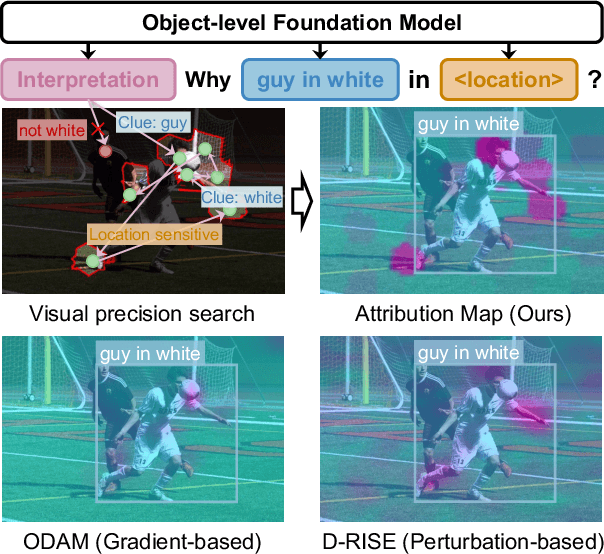

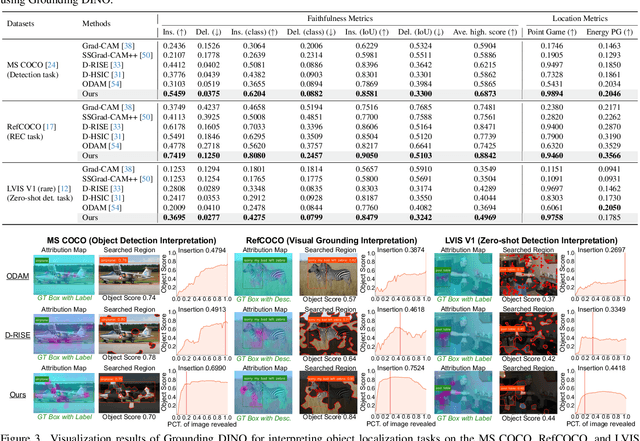
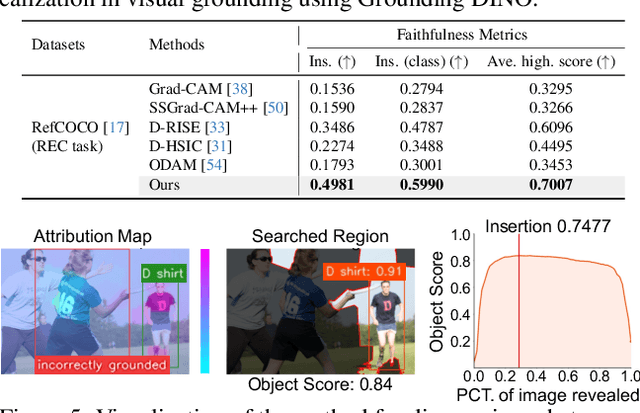
Abstract:Advances in multimodal pre-training have propelled object-level foundation models, such as Grounding DINO and Florence-2, in tasks like visual grounding and object detection. However, interpreting these models\' decisions has grown increasingly challenging. Existing interpretable attribution methods for object-level task interpretation have notable limitations: (1) gradient-based methods lack precise localization due to visual-textual fusion in foundation models, and (2) perturbation-based methods produce noisy saliency maps, limiting fine-grained interpretability. To address these, we propose a Visual Precision Search method that generates accurate attribution maps with fewer regions. Our method bypasses internal model parameters to overcome attribution issues from multimodal fusion, dividing inputs into sparse sub-regions and using consistency and collaboration scores to accurately identify critical decision-making regions. We also conducted a theoretical analysis of the boundary guarantees and scope of applicability of our method. Experiments on RefCOCO, MS COCO, and LVIS show our approach enhances object-level task interpretability over SOTA for Grounding DINO and Florence-2 across various evaluation metrics, with faithfulness gains of 23.7\%, 31.6\%, and 20.1\% on MS COCO, LVIS, and RefCOCO for Grounding DINO, and 102.9\% and 66.9\% on MS COCO and RefCOCO for Florence-2. Additionally, our method can interpret failures in visual grounding and object detection tasks, surpassing existing methods across multiple evaluation metrics. The code will be released at \url{https://github.com/RuoyuChen10/VPS}.
EyeDiff: text-to-image diffusion model improves rare eye disease diagnosis
Nov 15, 2024Abstract:The rising prevalence of vision-threatening retinal diseases poses a significant burden on the global healthcare systems. Deep learning (DL) offers a promising solution for automatic disease screening but demands substantial data. Collecting and labeling large volumes of ophthalmic images across various modalities encounters several real-world challenges, especially for rare diseases. Here, we introduce EyeDiff, a text-to-image model designed to generate multimodal ophthalmic images from natural language prompts and evaluate its applicability in diagnosing common and rare diseases. EyeDiff is trained on eight large-scale datasets using the advanced latent diffusion model, covering 14 ophthalmic image modalities and over 80 ocular diseases, and is adapted to ten multi-country external datasets. The generated images accurately capture essential lesional characteristics, achieving high alignment with text prompts as evaluated by objective metrics and human experts. Furthermore, integrating generated images significantly enhances the accuracy of detecting minority classes and rare eye diseases, surpassing traditional oversampling methods in addressing data imbalance. EyeDiff effectively tackles the issue of data imbalance and insufficiency typically encountered in rare diseases and addresses the challenges of collecting large-scale annotated images, offering a transformative solution to enhance the development of expert-level diseases diagnosis models in ophthalmic field.
Visual Question Answering in Ophthalmology: A Progressive and Practical Perspective
Oct 22, 2024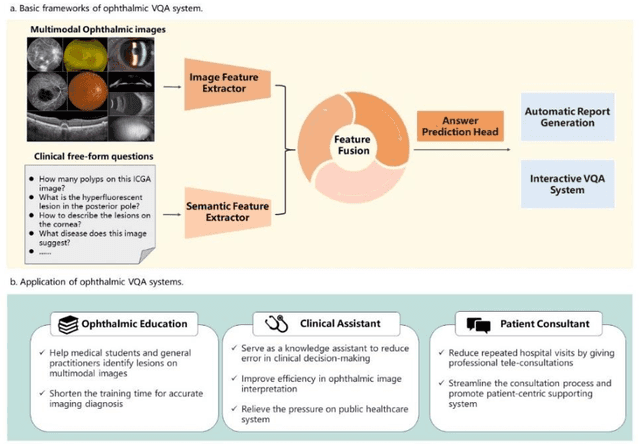
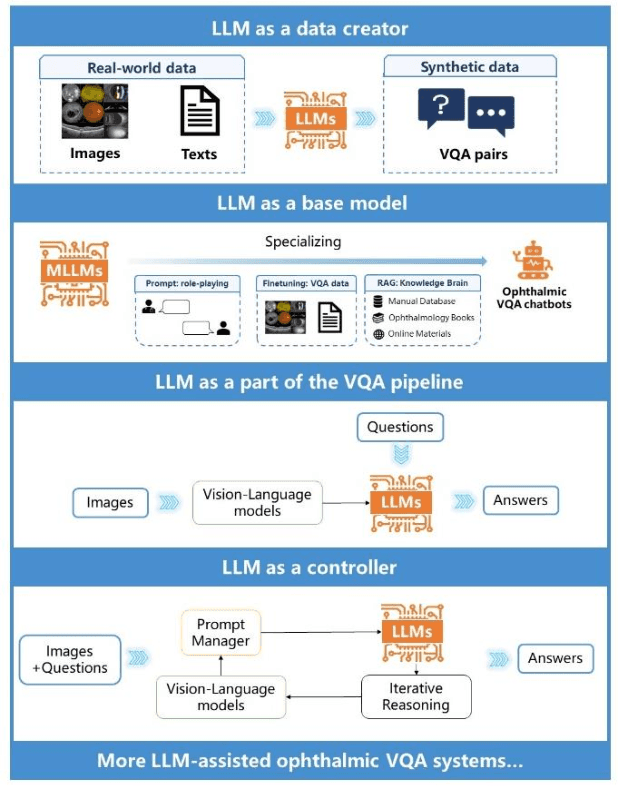
Abstract:Accurate diagnosis of ophthalmic diseases relies heavily on the interpretation of multimodal ophthalmic images, a process often time-consuming and expertise-dependent. Visual Question Answering (VQA) presents a potential interdisciplinary solution by merging computer vision and natural language processing to comprehend and respond to queries about medical images. This review article explores the recent advancements and future prospects of VQA in ophthalmology from both theoretical and practical perspectives, aiming to provide eye care professionals with a deeper understanding and tools for leveraging the underlying models. Additionally, we discuss the promising trend of large language models (LLM) in enhancing various components of the VQA framework to adapt to multimodal ophthalmic tasks. Despite the promising outlook, ophthalmic VQA still faces several challenges, including the scarcity of annotated multimodal image datasets, the necessity of comprehensive and unified evaluation methods, and the obstacles to achieving effective real-world applications. This article highlights these challenges and clarifies future directions for advancing ophthalmic VQA with LLMs. The development of LLM-based ophthalmic VQA systems calls for collaborative efforts between medical professionals and AI experts to overcome existing obstacles and advance the diagnosis and care of eye diseases.
Fundus to Fluorescein Angiography Video Generation as a Retinal Generative Foundation Model
Oct 17, 2024Abstract:Fundus fluorescein angiography (FFA) is crucial for diagnosing and monitoring retinal vascular issues but is limited by its invasive nature and restricted accessibility compared to color fundus (CF) imaging. Existing methods that convert CF images to FFA are confined to static image generation, missing the dynamic lesional changes. We introduce Fundus2Video, an autoregressive generative adversarial network (GAN) model that generates dynamic FFA videos from single CF images. Fundus2Video excels in video generation, achieving an FVD of 1497.12 and a PSNR of 11.77. Clinical experts have validated the fidelity of the generated videos. Additionally, the model's generator demonstrates remarkable downstream transferability across ten external public datasets, including blood vessel segmentation, retinal disease diagnosis, systemic disease prediction, and multimodal retrieval, showcasing impressive zero-shot and few-shot capabilities. These findings position Fundus2Video as a powerful, non-invasive alternative to FFA exams and a versatile retinal generative foundation model that captures both static and temporal retinal features, enabling the representation of complex inter-modality relationships.
UWF-RI2FA: Generating Multi-frame Ultrawide-field Fluorescein Angiography from Ultrawide-field Retinal Imaging Improves Diabetic Retinopathy Stratification
Aug 27, 2024



Abstract:Ultrawide-field fluorescein angiography (UWF-FA) facilitates diabetic retinopathy (DR) detection by providing a clear visualization of peripheral retinal lesions. However, the intravenous dye injection with potential risks hamper its application. We aim to acquire dye-free UWF-FA images from noninvasive UWF retinal imaging (UWF-RI) using generative artificial intelligence (GenAI) and evaluate its effectiveness in DR screening. A total of 18,321 UWF-FA images of different phases were registered with corresponding UWF-RI images and fed into a generative adversarial networks (GAN)-based model for training. The quality of generated UWF-FA images was evaluated through quantitative metrics and human evaluation. The DeepDRiD dataset was used to externally assess the contribution of generated UWF-FA images to DR classification, using area under the receiver operating characteristic curve (AUROC) as outcome metrics. The generated early, mid, and late phase UWF-FA images achieved high authenticity, with multi-scale similarity scores ranging from 0.70 to 0.91 and qualitative visual scores ranging from 1.64 to 1.98 (1=real UWF-FA quality). In fifty randomly selected images, 56% to 76% of the generated images were difficult to distinguish from real images in the Turing test. Moreover, adding these generated UWF-FA images for DR classification significantly increased the AUROC from 0.869 to 0.904 compared to the baseline model using UWF-RI images (P < .001). The model successfully generates realistic multi-frame UWF-FA images for enhancing DR stratification without intravenous dye injection.
 Add to Chrome
Add to Chrome Add to Firefox
Add to Firefox Add to Edge
Add to Edge